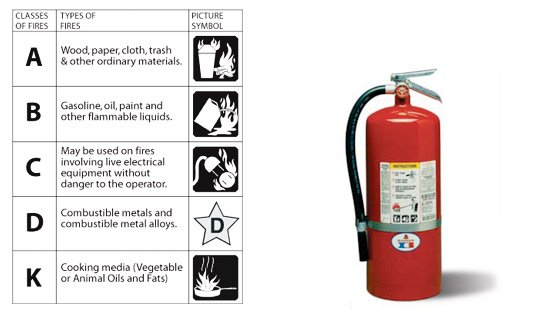Fire Extinguisher Safety
Fire extinguishers are devices that can put out or contain small fires. They only work if you know how to use them! Before even considering using a portable extinguisher, make sure you have access to a clear exit. Also, ensure that you are using the right extinguisher for the type of fire you are trying to put out.
First you should look for these symbols on the label:

These include common household items such as paper, wood and cloth.
Type B- Flammable Liquids
Gasoline, cooking oils or fats, oil-based paint and kerosene are just some of these.
Type C- Electrical Equipment
Wall outlets, power cords, small and large appliances, wiring and fuse boxes fall under this category.
**NOTE** Never use a "Type A" extinguisher on flammable liquids. This is likely to spread the fire and make it worse, or splash burning liquid onto you
**NOTE** Never use a "Type A" extinguisher on flammable liquids. This is likely to spread the fire and make it worse, or splash burning liquid onto you
Here's a simple way to remember the steps to take when using a portable extinguisher. Start by standing around 3 metres back from the fire.
Follow the acronym"P.A.S.S."
- Pull the pin. The pin is there as a safeguard and locks the handle. Pulling it out enables it for use.
- Aim low. The hose or nozzle should be pointed at the base of the fire to best put it out.
- Squeeze the lever above the handle. This will shoot the extinguishing substance from the hose or nozzle. Keep in mind that most small extinguishers will run out of their extinguishing agent in 10 to 25 seconds.
- Sweep from side to side. As you move slowly toward the fire, keep the hose or nozzle aimed at the base of the fire. If the flames appear to be out, release the handle and watch closely. If the fire ignites again, repeat the process.
- Before you use an extinguisher to fight small fires, make sure everyone else has left the area and that firefighters have been called using 911.
- Always have an exit route at your back. Never let the fire get between you and the way out.
- Call the fire department to inspect the fire area, even if you are sure you have extinguished the fire.
- Once a month, inspect your extinguisher for damage and make sure it is properly charged (see manufacturer's instructions for details).
- If you use an extinguisher, it must be recharged by a professional. If it is a disposable unit, throw it out.
